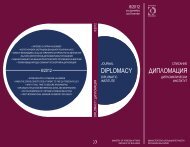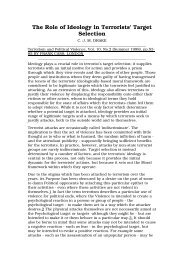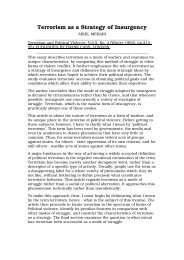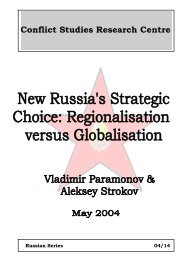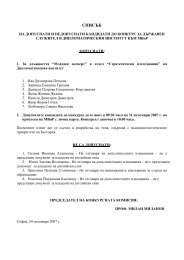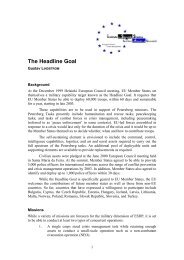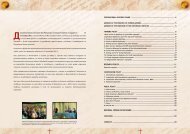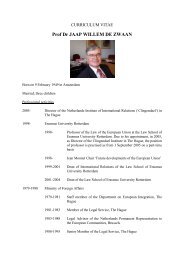The Myth of Ethnic Conflict: Chap 13 - Diplomatic Institute
The Myth of Ethnic Conflict: Chap 13 - Diplomatic Institute
The Myth of Ethnic Conflict: Chap 13 - Diplomatic Institute
You also want an ePaper? Increase the reach of your titles
YUMPU automatically turns print PDFs into web optimized ePapers that Google loves.
474 Maria Todorova<br />
the nineteenth- and twentieth-century European nation-state: ethnic<br />
and religious homogeneity. All Balkan countries (Turkey inclusive)<br />
resorted to similar solutions in trying to solve their minority problems<br />
in the new context: (forced) emigration and assimilation. <strong>The</strong><br />
failure <strong>of</strong> these policies and the subsequently unresolved minority<br />
issues are essentially the sources <strong>of</strong> existing and potential crisis<br />
points in the Balkans: Bosnia, Macedonia, Kosovo, Transylvania,<br />
Thrace.<br />
Turning specifically to the case <strong>of</strong> Bulgaria, we see that in many<br />
ways the institutional legacies <strong>of</strong> Ottoman rule and the development<br />
<strong>of</strong> the modern nation-state have created conditions similar to those<br />
found throughout the Balkans—with an important exception: although<br />
relations between Bulgarian Christians and Bulgarian Muslims<br />
have at times been quite bloody, today the potential for renewed<br />
conflict seems relatively low in relation to what can be found in other<br />
parts <strong>of</strong> the region. To understand how this is so, we need to understand<br />
the particularities <strong>of</strong> the case.<br />
<strong>The</strong> Pomaks inhabit several regions <strong>of</strong> Bulgaria but are concentrated<br />
as a compact mass almost entirely in the Rhodope Mountains,<br />
where they have practiced their traditional occupations—mostly<br />
animal husbandry, but also agriculture—for centuries. 5 <strong>The</strong> process<br />
<strong>of</strong> their conversion to Islam has been gradual and protracted and,<br />
despite some excellent research, impossible to reconstruct in all its<br />
details and historical depth. <strong>The</strong> historiography which traces the<br />
gradual process <strong>of</strong> Islamization <strong>of</strong> the local Christian inhabitants<br />
from Ottoman registers beginning in the sixteenth century is the<br />
most convincing from a scholarly point <strong>of</strong> view. 6 Its conclusions are<br />
well corroborated by the daily and active coexistence between Bulgarian<br />
Christians and Muslims, who in some cases keep memories<br />
<strong>of</strong> their kinship alive. 7 At the same time, there is a whole body <strong>of</strong><br />
journalistic and partly academic literature which has built on folk<br />
legends and insists on the abrupt, violent mass conversion <strong>of</strong> the<br />
population in the second half <strong>of</strong> the seventeenth century. Despite the<br />
pr<strong>of</strong>ound intellectual and ideological strain between these two explanations,<br />
they interface on one point: that the converts were part<br />
<strong>of</strong> the already consolidated Bulgarian ethnic group and that by converting<br />
to Islam, their conscious Bulgarian ethnicity was weakened<br />
or completely obliterated. Against this, Greek historiography, having<br />
to deal with a Pomak presence in its own part <strong>of</strong> the Rhodopes,



